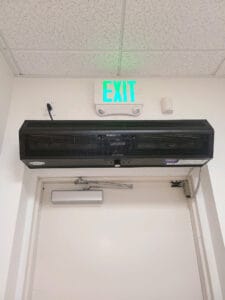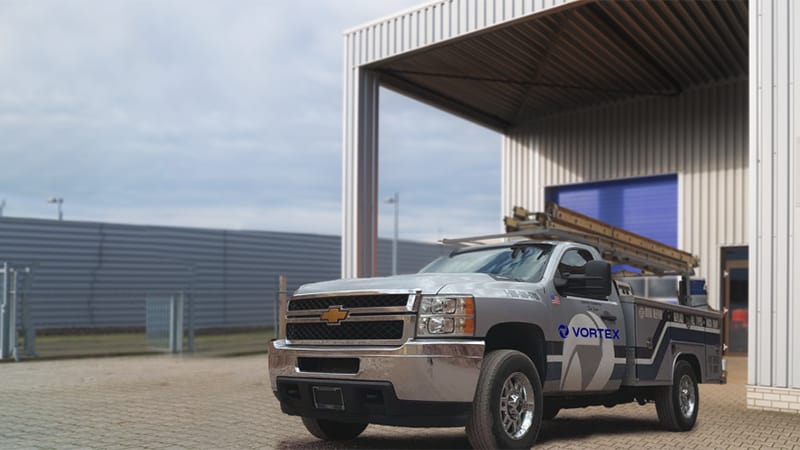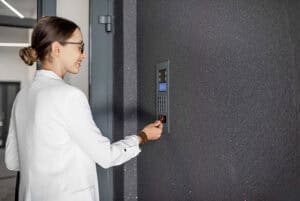What is an Air Curtain?
 Climate control is a challenge for both residential and commercial buildings. Most homeowners solve the problem by shutting their doors and windows, an option generally unavailable to business owners, who need to keep their buildings open to the public.
Climate control is a challenge for both residential and commercial buildings. Most homeowners solve the problem by shutting their doors and windows, an option generally unavailable to business owners, who need to keep their buildings open to the public.
One often-overlooked solution is air curtains. Also known as air doors, they create an invisible barrier that separates outdoor weather from heated or air conditioned spaces. Commercial air curtains separate temperature zones without the need for a physical barrier, leaving more usable space for forklifts, workers, and pallet jacks. In high-traffic areas, they minimize congestion and allow for smoother and faster traffic, while producing energy savings at the same time.
How Do Air Curtains Work?
Air curtains operate by creating a powerful jet stream that prevents outside air from interfering with interior temperature controls. Once the unit is installed, it pulls in ambient air and accelerates it down through a plenum (a central distribution space within an HVAC system), which ensures it’s evenly distributed along the entire doorway before being blasted out at high speed. Despite its strength, air flow is relatively uniform, with minimal turbulence as it blows across the opening. Around eighty percent of the air is directed back into the room, while the remaining twenty percent is directed outside.
What Are the Benefits of An Air Curtain?
When it comes to climate control, air barriers are every bit as effective as solid doors. By recirculating air, they reduce the number of heating and cooling cycles necessary to sustain your desired temperature. Even though they’re designed to run continuously, their electrical requirements are low. But besides reducing the strain on your furnace and air conditioner, air curtains provide several other benefits.
- Increased Productivity. Comfortable temperatures ensure machinery operates efficiently. They also make it easier for employees to carry out their assigned tasks.
- High Air Quality. Industrial air curtains prevent dust, dirt, and pollutants from entering your facility, ensuring a healthy environment even when working with open doors.
- Pest Control. Flying insects can’t penetrate high-velocity air curtains. They get swept away before they can enter your facility, preventing them from contaminating your assets or inventory.
- De-Stratified Air. Due to convection and thermal expansion, most rooms don’t have a uniform temperature, but layers of hot air and cold air. Air curtains disrupt this situation. When they hit the floor, they create an air current that forces cold air upwards and pulls warm air down, evening the room temperature.
- Clear Lines of Sight. Transporting goods through a crowded warehouse can lead to accidents. Doors block lines of sight, but air curtains preserve them. By giving drivers and staff a clear view of who or what is in front of them, they reduce the risk of collision and injury.
Where Are They Used?
Air curtains are precision engineered. Their size and power depends on the height and width of the opening, as well as their application. Though not suitable for every entryway, air curtains are an efficient and effective solution for a number of businesses, including:
- Hospitals. Air barriers regulate temperature in healthcare facilities. They also shield sensitive areas from airborne pathogens. For added protection, UV and HEPA filters can be installed in order to sterilize indoor air.
- Grocery Stores. Found normally in cold storage, air curtains allow supermarkets and retailers to protect storerooms that require constant refrigeration. They not only control temperatures. They also prevent infiltration by flies, bees, and other pests.
- Loading Docks. Air curtains can protect dock doors up to 30 feet high. They allow shipping companies to keep their doors open during the loading and unloading process without compromising energy efficiency.
- Drive-Thrus. Installing an air curtain allows food service employees to hand meals and collect money through open windows while minimizing energy costs.
- Manufacturing. Placing an air curtain inside a clean room creates an effective but inexpensive barrier against low-level contaminants which could jeopardize the precision and quality of pharmaceuticals, electronics, medical devices, and other hi-tech products.
According to the American Society of Heating and Air-Conditioning Engineers (ASHRAE), air curtains are also an acceptable alternative for vestibules as long as they maintain a 400-ft/min. airstream velocity at the floor. Installing air curtains allows businesses to retrofit existing vestibules in order to repurpose the space for more productive use.
Air Curtain Maintenance
Vortex repairs and services all types of door systems and equipment, including air curtains. Our technicians ensure optimal performance and longevity by cleaning fans and air filters, removing debris that could restrict air flow and increase mechanical wear. Contact us today to learn more about our dedicated maintenance programs.










